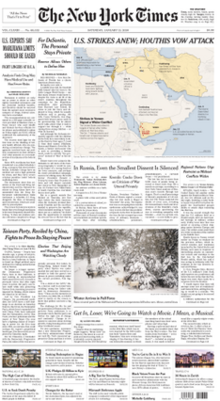News Articles - Questions
Table of ContentsThe 7-Minute Rule for News ArticlesHow News Articles can Save You Time, Stress, and Money.Not known Factual Statements About News Articles Examine This Report on News ArticlesOur News Articles PDFs
Good knowledge of various subjects provides students an one-upmanship over their peers. Despite the fact that electronic and social media sites are easily obtainable, we should not neglect exactly how vital it is to check out the papers. Parents have to try and instill the habit of reviewing a newspaper as an everyday regimen to continue the tradition of the revered print medium.Information tales also contain at least one of the adhering to important features relative to the designated audience: proximity, importance, timeliness, human rate of interest, anomaly, or consequence.
Within these limitations, news tales additionally intend to be thorough. Other factors are involved, some stylistic and some derived from the media form. Among the larger and more respected papers, justness and equilibrium is a significant consider offering info. Discourse is typically restricted to a separate section, though each paper might have a various general slant.
Newspapers with a worldwide audience, for instance, tend to use a much more formal design of creating. The certain options made by a news outlet's editor or content board are often collected in a style overview; common style guides consist of the and the United States News Design Book. The main objectives of news writing can be summed up by the ABCs of journalism: accuracy, brevity, and quality.
Not known Incorrect Statements About News Articles
As a regulation, journalists will certainly not use a long word when a short one will do. News writers try to avoid using the same word more than once in a paragraph (occasionally called an "echo" or "word mirror").
Headlines in some cases leave out the subject (e.g., "Jumps From Boat, Catches in Wheel") or verb (e.g., "Cat woman fortunate"). A subhead (additionally subhed, sub-headline, subheading, caption, deck or dek) can be either a subservient title under the major heading, or the heading of a subsection of the post. It is a heading that precedes the main text, or a team of paragraphs of the primary text.

of a write-up topic, informant, or interviewee), it is referred to as a pulled quotation or draw quote. Added billboards of any of these types may appear later in the short article (particularly on succeeding web pages) to lure more analysis. Journalistic websites sometimes use animation techniques to swap one billboard for another (e.g.
News Articles Can Be Fun For Everyone
Such billboards are also made use of as guidelines to the short article in various other sections of the publication or website, or as advertisements for the item in various other publication or websites. Press release of the Swiss federal government. Regular structure with title, lead paragraph (recap in bold), other paragraphs (details) and contact info.

Instance of a hard-lead paragraph NASA is recommending another room job. The budget demands around $10 billion for the project.
An "off-lead" is the 2nd most essential front web page information of the day. To "hide the lead" is to begin the article with history details or information of second value to the viewers, compeling them to check out more deeply right into a post than they must have to in order to find the necessary points.
Fascination About News Articles
Typical usage is that one or 2 sentences each form their own paragraph. Reporters usually describe the organization or structure of a newspaper article as an inverted pyramid. The essential and most fascinating aspects of a story are placed at the start, with sustaining info complying with in order of lessening importance.
It allows individuals to discover a topic to just the see this page depth that their curiosity takes them, and without the imposition of details or subtleties that they might take into consideration unnecessary, yet still making that details readily available to a lot more interested viewers. The inverted pyramid framework likewise makes it possible for posts to be trimmed to any arbitrary length during layout, to suit the space offered.
Some writers start their stories with the "1-2-3 lead", yet there are many sort of lead readily available. This format inevitably begins with a "Five Ws" opening paragraph (as defined above), followed by an indirect quote that serves to sustain a significant component of the first paragraph, and after that a straight quote to support the indirect quote. [] A kicker can describe several points: The last tale in the news broadcast; a "happy" tale to end the program.
Longer posts, such as publication cover write-ups and the pieces that lead the inside areas of a newspaper, are recognized as. Feature tales vary from straight news in a number of ways.
The News Articles Ideas
A feature's very first paragraphs commonly associate an interesting moment or event, as in an "anecdotal lead". From the details of an individual or episode, its sight promptly expands to generalizations regarding the story's this hyperlink topic.

The Editor's Tool kit: A Recommendation Guide for Beginners and Professionals (2001) Allan M. Siegal and William G. Connolly. The New York City Times Manual of Design and Use: The Authorities Design Overview Made Use Of by the Writers and Editors of the World's Most Reliable Newspaper (2002) M. L. Stein, Susan Paterno, and R.